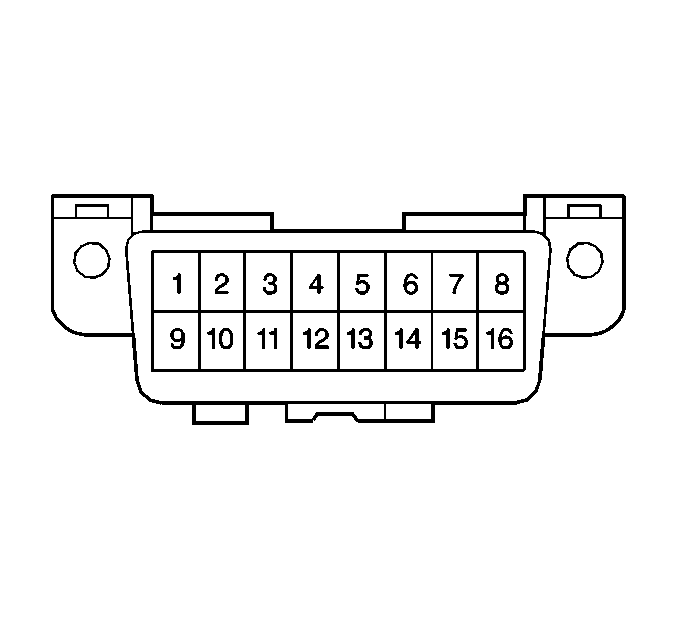Diagnostic Information
Use the Diagnostic Trouble Code (DTC) tables in this section in order
to locate a faulty circuit or a component through the process of elimination.
The BCM performs a continual self-diagnosis on certain control functions.
A DTC sets when a malfunction is detected by the BCM. The BCM will not turn
the SERVICE ENGINE SOON malfunction indicator lamp (MIL) ON.
Class 2 Serial Data Communication
The Class 2 network continually monitors various subsystems (i.e.
BCM, IPC, BPCM, and ABS) and operating conditions for possible system malfunctions.
Compare the system conditions against standard operating limits in order
to detect certain circuit and component malfunctions. A 5-digit alphanumeric
diagnostic trouble code (DTC) is stored in the computer memory. When a malfunction
is detected by this self-diagnostic system, the DTC(s) may later be retrieved
by the service technician using a scan tool. The scan tool may aid the technician
in repairing various subsystems.
Data Link Connector (DLC)

The 16-pin DLC is wired to the body control module. The 16-pin DLC is
located under the dash panel on the left side. The DLC connector has terminals
that are used in order to connect to a scan tool. The following list shows
some common uses of the scan tool:
| • | Identifying stored diagnostic trouble codes (DTCs) |
| • | Performing output control tests |
Scan Tool Diagnosis
Use the scan tool in order to monitor the communications between the
BCM, the BBPCM and the PIM. The scan tool can also display data for these
modules. The DATA LIST display is located under the applicable selections.
These lists show the status of the hard-wired connections and the Class 2
values for these modules. These scan tool values can be very useful in diagnosing
the below systems.
| • | Power Inverter Module (PIM) |
| • | Body Control Module (BCM) |
| • | Battery Pack Control Module (BPCM) |
Scan Tool Information Modes
On the scan tool, four modes are available in the body control module
selection. Select the following items:
- Body control module
- Data display
- Data list
The following list appears on the scan tool:
The scan tool allows for the for the display of Class 2 values,
or the state of components commanded by the various systems (i.e. BCM, IPC,
ABS and BPCM). The tests available are dependent upon the system selected,
but may include the following modes:
Data (analog inputs): This test displays analog values as seen by the system.
Inputs (digital inputs): This test displays digital values as seen by the system and provides
an indication of whether the input has cycled.
Outputs (digital outputs): This test allows for digital outputs controlled by the BCM system
in order to be turned OFF/ON.
Special functions (analog outputs): This test allows for analog outputs of the BCM system to be set
at a desired value.
Clear diagnostic trouble codes (DTCs): This test will erase all DTCs stored for the system currently selected.
If the malfunction is still present, the DTC may immediately reset.
The Diagnostic Executive
The diagnostic executive is a unique segment of software that is designed
in order to perform the following functions:
| • | Coordinate and prioritize the diagnostic procedures |
| • | Define the protocol for recording and displaying the results |
| • | Receive the diagnostic test results and records the pass and the
fail status |
The following list shows the main responsibilities of the diagnostic
executive:
| • | Monitor the diagnostic test-enabling conditions |
| • | Monitor and record test status information |
| • | Record pass and fail status of test results |
A diagnostic test is a series of steps that has a beginning and an end.
The result of a diagnostic test is pass or fail, which is reported to the
diagnostic executive. When a diagnostic test reports a pass result, the diagnostic
executive records the following data:
The fault identified by the diagnostic test is not currently active.
When a diagnostic test reports a fail result, the diagnostic executive
records the following data:
| • | The fault identified by the diagnostic test is currently active. |
| • | The fault identified by the diagnostic test has been active since
the last 100 ignition cycles or since the codes have been cleared. |
| • | The code supported BIT is enabled. |
Diagnostic Trouble Code (DTC) Diagnosis
This section uses the following items in order to direct you in performing
specific tests in order to locate and repair the problem:
The diagnostic table is a step by step procedure used in order to determine
the circuit or the component that is the source of the problem. The following
items are located above the diagnostic table:
| • | Actions taken when a DTC is set |
When the diagnostic trouble codes (DTCs) are set, the BCM detects a
malfunction in a particular circuit or other system. Other system malfunctions
are generally (but not exclusively) reported to the BCM via Class 2
data message. The BCM is programmed with routines for internal checks that
the BCM follows only under prescribed conditions (called test conditions).
When these conditions exist, the BCM inspects certain circuits or systems
for a malfunction. These inspections are called failure conditions or conditions
for setting the DTC. When these conditions are true, a DTC is set. Refer to
the applicable DTC table for procedures and details.

